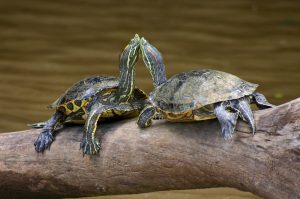|
Getting your Trinity Audio player ready...
|
 Turtles are reptiles, not amphibians. People often mistake them for amphibians due to the misunderstanding about the term amphibian. The word amphibian refers specifically to members of the class amphibia, but the word amphibious that comes from the same root means “operating or living on land and in water.” It is true that many turtles are amphibious, but none are actually amphibians.
Turtles are reptiles, not amphibians. People often mistake them for amphibians due to the misunderstanding about the term amphibian. The word amphibian refers specifically to members of the class amphibia, but the word amphibious that comes from the same root means “operating or living on land and in water.” It is true that many turtles are amphibious, but none are actually amphibians.
Yes, turtles belong to the class of cold-blooded animals called reptiles. In British English, a turtle is a type of reptile which either lives in the sea or in freshwater. If you’re a speaker of North American English, however, ‘turtle’ is a broader term: it refers to any reptile belonging to the order Testudines, including those that live on land (which British English speakers call tortoises or terrapins rather than turtles). The former name for the order Testudines was Chelonia, which is why all members of this order (turtles, tortoises, and terrapins) are known as chelonians.
A few rules for being able to tell if something is an amphibian or a reptile are as follows:
- Reptiles have scales, whether they are large, small, rough, smooth, etc. This protective layer helps them conserve water and has also allowed them to spread across land in a way that amphibians are incapable of.
- Amphibians have smooth, soft skin that is incredibly porous and must hold moisture to help them breathe. Due to this, they must always stay close to a water source so their skin does not dry out.
- Reptiles have claws or nails, amphibians do not.
- Reptiles only breathe air through their lungs.
- Amphibians are born breathing with gills until they develop lungs later in life when they are older.
- Reptiles lay eggs that have a tough, leathery shell.
- Amphibian’s eggs are soft and need to be laid in water or in damp places.
Some people think that turtles might be classed as amphibians. Admittedly, reptiles and amphibians are both types of cold-blooded creature and, like amphibians, some turtles can live on both land and in water. However, there are some major differences between reptiles and amphibians, as outlined below, which make it clear why turtles are reptiles:
Reptiles:
- Class comprises types which live on land (snakes, lizards, tortoises); mainly in water (turtles); on both (crocodiles and alligators). No reptiles have an immature (larval) aquatic stage.
Breathe by means of lungs. - Have dry scaly skin.
- Lay eggs on land; eggs have shells.
Amphibians:
- Class comprises frogs, toads, newts, salamanders, and caecilians: typically have an aquatic larval stage (e.g. tadpole) followed by a terrestrial adult stage.
- Breathe by means of gills (during larval stage) and lungs (during adult stage).
- Have smooth skin; adults use skin as secondary respiratory organ.
- Typically lay eggs in water; eggs are surrounded by gelatinous covering
Did you know that if you subscribe to our website, you will receive email notifications whenever content changes or new content is added.
1. Enter your e-mail address below and click the Sign Me Up button.
2. You will receive an email asking you to confirm your intention of subscribing to our site.
3. Click the link in the email to confirm. That’s all there is to it! Note: if you wish to unsubscribe from our site, click the unsubscribe link at the bottom of the email you received.
Then indicate you no longer wish to receive our emails.
Thank You
Dialect Zone International